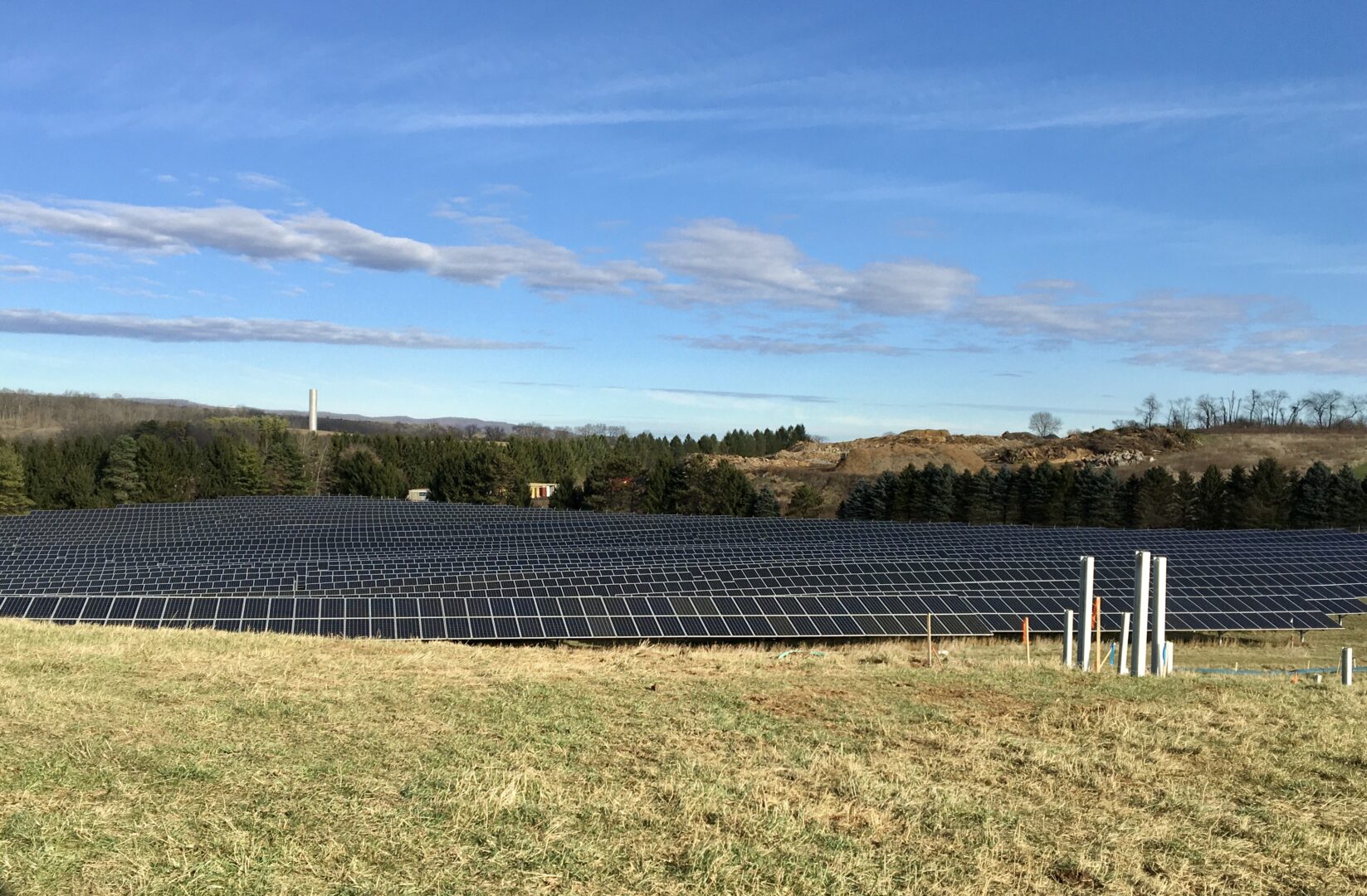
The University Area Joint Authority in Centre County had a solar array installed on its property, in large part to save money.
Anne Danahy / WPSU


The University Area Joint Authority in Centre County had a solar array installed on its property, in large part to save money.
Anne Danahy / WPSU

Anne Danahy / WPSU
The University Area Joint Authority in Centre County had a solar array installed on its property, in large part to save money.
Stormwater runoff concerns are often raised when developers propose large solar energy projects.
A new Penn State study published in Journal of Hydrology shows both natural and built solutions can stop runoff becoming a problem.
Researchers measured soil moisture at two solar fields near State College that are built on hillsides. They used continuously operating sensors to take measurements under the panels; at the edge of panels, where most rain water would fall off; in open space between rows of panels; and in open space nearby but apart from the solar array.
The study found moisture levels were 19% higher at the drip line than nearby land. Under the panels, moisture was 25% lower than nearby land. The results are the average for both solar farms over one year.
Author Lauren McPhillips said soil got drier, faster in the space between the panels, meaning water was able to soak into the ground. She said that shows it’s important to keep soil healthy with plants and not compact the soil during construction.
“That’s all really important to helping leverage the kind of natural power of the landscape to help infiltrate and soak in any of that runoff that might be generated,” she said.
Monitors placed in stormwater basins built at the base of the slopes show the basins did not fill completely over the course of the study.
McPhillips said they can then assume that the combination of plants and infrastructure were effectively capturing all the runoff.
“What I would like to see in the future is more fine-tuned guidance about right-sizing stormwater features, so they’re big enough to capture the runoff, but not too big to just make it incredibly expensive,” McPhillips said.
McPhillips noted her lab was not able to collect data on the sites before the solar panels were installed, so it’s difficult to know what the correct size for stormwater infrastructure would be. Her team is working on models to estimate what’s needed at sites with different landscapes.
Climate change is affecting rainstorm intensity and will also need to be factored into the design of future solar fields.
In Pennsylvania, many solar projects have been proposed for farmland, which is often fairly flat.
McPhillips said it’s important to see how solar development can work on more challenging terrain, to help avoid perceived conflicts with productive farmland.
Scientists not involved in the study say the paper could be useful as developers and municipalities consider the impacts of solar panels.
Siobhan Fathel is an environmental science professor at Susquehanna University who studies sediment transfer. She has worked with the authors of the study when she was employed at Penn State, but was not involved in this paper.
She said the research shows management matters.
“Management doesn’t just mean what’s in the ground, but also what’s planted on the land surface,” Fathel said. “It seems to be a team effort. It is helpful to have those drainage basins, but if you didn’t have the vegetation, I don’t know if they would hold up.”
More plants on solar sites can also have benefits for wildlife and address concerns about appearance.
Fathel said it would be interesting to see similar research for different types of land, including forests, rocky terrain, and reclaimed minelands.
Gov. Josh Shapiro has proposed getting 35% of the state’s power from renewables, including solar.
The Solar Energy Industries Association says a utility-scale solar power plant may take up between five and 10 acres of land per megawatt of generating capacity, depending on the technology used. That means a significant increase in solar energy could require a lot of land.
“Folks should care because this could be a really big change to our state in terms of what we see when we drive around, but also what’s happening to farms and forests and some of those abandoned mine sites,” Fathel said.
StateImpact Pennsylvania is a collaboration among WITF, WHYY, and the Allegheny Front. Reporters Reid Frazier, Rachel McDevitt and Susan Phillips cover the commonwealth’s energy economy. Read their reports on this site, and hear them on public radio stations across Pennsylvania.
(listed by story count)
StateImpact Pennsylvania is a collaboration among WITF, WHYY, and the Allegheny Front. Reporters Reid Frazier, Rachel McDevitt and Susan Phillips cover the commonwealth’s energy economy. Read their reports on this site, and hear them on public radio stations across Pennsylvania.
Climate Solutions, a collaboration of news organizations, educational institutions and a theater company, uses engagement, education and storytelling to help central Pennsylvanians toward climate change literacy, resilience and adaptation. Our work will amplify how people are finding solutions to the challenges presented by a warming world.